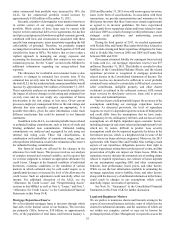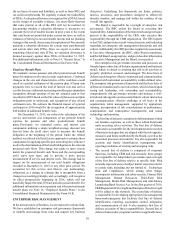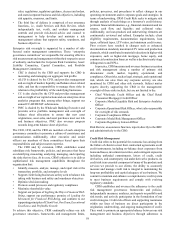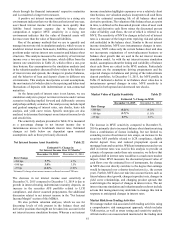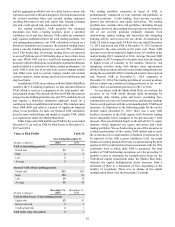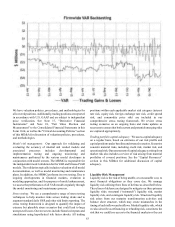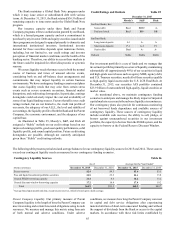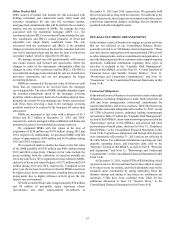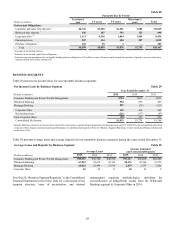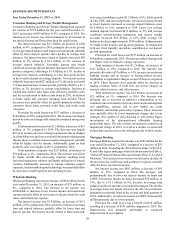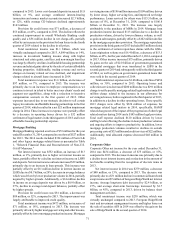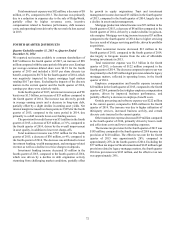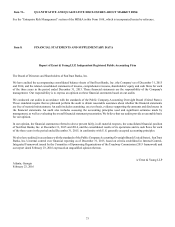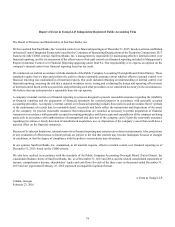SunTrust 2015 Annual Report Download - page 93
Download and view the complete annual report
Please find page 93 of the 2015 SunTrust annual report below. You can navigate through the pages in the report by either clicking on the pages listed below, or by using the keyword search tool below to find specific information within the annual report.
65
The Bank maintains a Global Bank Note program under
which it may issue senior or subordinated debt with various
terms. At December 31, 2015, the Bank retained $36.5 billion of
remaining capacity to issue notes under the Global Bank Note
program.
Our issuance capacity under these Bank and Parent
Company programs refers to authorization granted by our Board,
which is a formal program capacity and not a commitment to
purchase by any investor. Debt and equity securities issued under
these programs are designed to appeal primarily to domestic and
international institutional investors. Institutional investor
demand for these securities depends upon numerous factors,
including, but not limited to, our credit ratings and investor
perception of financial market conditions and the health of the
banking sector. Therefore, our ability to access these markets in
the future could be impaired for either idiosyncratic or systemic
reasons.
We assess liquidity needs that may occur in both the normal
course of business and times of unusual adverse events,
considering both on and off-balance sheet arrangements and
commitments that may impact liquidity in certain business
environments. We have contingency funding scenarios and plans
that assess liquidity needs that may arise from certain stress
events such as severe economic recessions, financial market
disruptions, and credit rating downgrades. In particular, a ratings
downgrade could adversely impact the cost and availability of
some of our liquid funding sources. Factors that affect our credit
ratings include, but are not limited to, the credit risk profile of
our assets, the adequacy of our ALLL, the level and stability of
our earnings, the liquidity profile of both the Bank and the Parent
Company, the economic environment, and the adequacy of our
capital base.
As illustrated in Table 25, Moody’s, S&P, and Fitch all
assigned a “Stable” outlook on our credit ratings based on our
improved earnings profile, good asset quality performance, solid
liquidity profile, and sound capital position. Future credit rating
downgrades are possible, although not currently anticipated
given these “Stable” credit rating outlooks.
Credit Ratings and Outlook Table 25
December 31, 2015
Moody’s S&P Fitch
SunTrust Banks, Inc.:
Senior debt Baa1 BBB+ A-
Preferred stock Baa3 BB+ BB
SunTrust Bank:
Long-term deposits A1 A- A
Short-term deposits P-1 A-2 F1
Senior debt Baal A- A-
Outlook Stable Stable Stable
Our investment portfolio is a use of funds and we manage that
investment portfolio primarily as a store of liquidity, maintaining
substantially all (approximately 98%) of our securities in liquid
and high-grade asset classes such as agency MBS, agency debt,
and U.S. Treasury securities; nearly all of these securities qualify
as high-quality liquid assets under the U.S. LCR Final Rule. At
December 31, 2015, our securities AFS portfolio contained
$23.9 billion of unencumbered high-quality, liquid securities at
market value.
As mentioned above, we maintain contingency funding
scenarios to anticipate and manage the likely impact of impaired
capital markets access and other adverse liquidity circumstances.
Our contingency plans also provide for continuous monitoring
of net borrowed funds dependence and available sources of
contingency liquidity. These sources of contingency liquidity
include available cash reserves, the ability to sell, pledge, or
borrow against unencumbered securities in our investment
portfolio, the capacity to borrow from the FHLB system, and the
capacity to borrow at the Federal Reserve Discount Window.
The following table presents period end and average balances for our contingency liquidity sources for 2015 and 2014. These sources
exceed our contingent liquidity needs as measured in our contingency funding scenarios.
Contingency Liquidity Sources Table 26
As of Average for the Year Ended ¹
(Dollars in billions) December 31, 2015 December 31, 2014 December 31, 2015 December 31, 2014
Excess reserves $2.4 $4.5 $3.6 $3.5
Free and liquid investment portfolio securities 23.9 22.2 23.1 13.8
Unused FHLB borrowing capacity 21.4 8.4 16.2 13.2
Unused discount window borrowing capacity 17.2 18.4 17.4 19.2
Total $64.9 $53.5 $60.3 $49.7
1 Average based upon month-end data, except excess reserves, which is based upon a daily average.
Parent Company Liquidity. Our primary measure of Parent
Company liquidity is the length of time the Parent Company can
meet its existing and certain forecasted obligations using its cash
resources. We measure and manage this metric using forecasts
of both normal and adverse conditions. Under adverse
conditions, we measure how long the Parent Company can meet
its capital and debt service obligations after experiencing
material attrition of short-term unsecured funding and without
the support of dividends from the Bank or access to the capital
markets. In accordance with these risk limits established by


